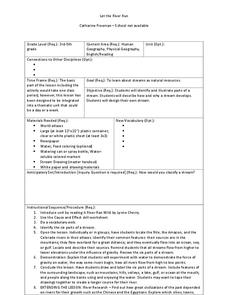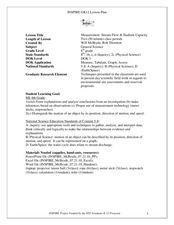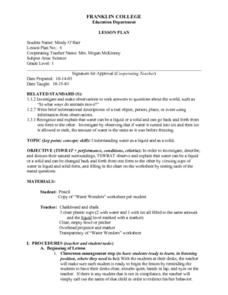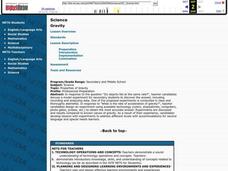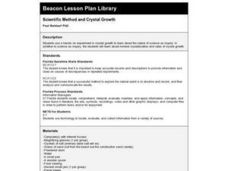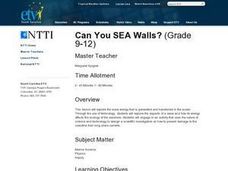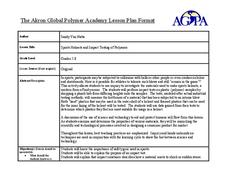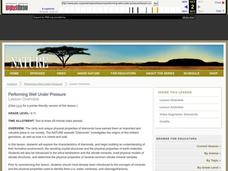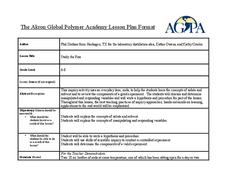Curated OER
Let the River Run
Students explore the environment by reading a story in class. In this water formation lesson, students define environmental terms such as rivers, streams, gulf, oceans and lakes. Students read the story A River Ran Wild and discuss the...
Curated OER
Ohm's Law
If your future physicists know how to construct simple circuits, include resistors, and use a multi-meter to measure voltage, then you might employ this lesson on Ohm's law. Each lab group investigates the relationships among voltage,...
Curated OER
Measurement: Stream Flow & Stadium Capacity
Eighth graders study the scientific fields and how information can be monitored and recorded. For this scientific inquiry lesson students view a PowerPoint presentation and complete a hands on activity.
Curated OER
Current Thinking About Magnets
Students construct their own magnet and wire device. In this inquiry instructional activity, students investigate the factors affecting the strength of magnetic forces. They manipulate different variable to determine their effect.
Curated OER
Water - Solid and Liquid
First graders conduct a science inquiry by comparing water in its liquid and solid form. The students describe the different stages of water and complete a worksheet answering questions about each form of the water. Teacher assessment...
Curated OER
Salty Sea Water
Young scholars conduct an experiment to find out if there is salt in the ocean. In this scientific inquiry lesson, students pour a cup of salt water onto an aluminum plate and observe the changes over a few days. Young scholars complete...
Curated OER
Does salt have an effect on the temperature of ice?
Learners explore the effect that salt has on the temperature of ice. In this scientific inquiry instructional activity, students observe an experiment to see how cold ice can get when salt is added. Learners then explore how the ice...
Curated OER
What Sticks Can Make You Sick
Students study adhesins and their receptors. In this science inquiry lesson students experiment to find adherence and use agglutination to identify adhesins.
Curated OER
Food Matters
Fifth graders identify physical and chemical changes. In this science inquiry lesson, 5th graders observe the changes that occur when making bread and butter. Students explain if the product is result of a physical or chemical change.
Curated OER
Gravity
Students perform inquiry in response to the question "Do objects fall at the same rate?", teacher candidates discuss a model experiment for secondary students to discover the answer, including recording and analyzing data.
Curated OER
Pulling It All Together
Students review data about a health problem and prepare an investigative report. Teams trade reports and utilize skills developed from previous lessons to evaluate the critical thinking evident in the reports.
Curated OER
School Lighting Audit Action Plan
Students write a school lighting audit action plan from the data they collected in previous lessons. They develop a presentation that shows the results of the data and their recommendations. They present their action plan to their...
Curated OER
Look at those Leaves!
Students observe leaves for patterns and similarities. In this science instructional activity, students sort through a pile of leaves to find patterns and take measurements. Students make leaf rubbings to view the details of the leaves.
Curated OER
Photosynthesis and Cell Respiration
Fifth graders participate in scientific inquires regarding the concepts of photosynthesis and cell respiration. In this photosynthesis and cell respiration lesson, 5th graders describe the process of photosynthesis with relation to...
Curated OER
Scientific Method and Crystal Growth
Students conduct a hands-on experiment growing crystals to demonstrate the nature of science as inquiry. They discuss and test variables that affect crystal growth. They research mineral crystallization and mineral formation on the...
Curated OER
Conducting a Scientific Investigation
Students investigate a possible health problem in the local school district through inquiry into attendance records, activities, maps, graphs, and data tables. The simulation continues as solutions for the problem are sought.
Curated OER
Can You SEA Walls?
Learners explore how wave energy that is generated and transferred in the ocean. They explore the aspects of a wave and how its energy affects the ecology of the seashore. Students engage in an activity that uses the nature of science...
Curated OER
Animal Investigation
In this lesson, Animal Investigation, 2nd graders will develop investigative and inquiry skills. Students choose one animal as a class to observe. Students ask questions about the animal and record observations, or answers to the...
Curated OER
Giraffe Riff Raff
Students study the effects of wildlife conservation and relocation. In this conservation lesson students view video on the preservation of the giraffe populations and discuss the impact that humans have had on them.
Curated OER
Ziplock Chemistry
Students investigate various chemical reactions when creating mixtures in ziplock baggies. In this chemistry lesson, students will recognize various chemical reactions and cite evidence. Safety and assessment strategies are included in...
Curated OER
Sports Helmets and Impact Testing of Polymers
Students examine the importance of good quality safety gear. In this investigative lesson, students will tests various polymers, collect data, and analyze the data to determine which polymer is best for safety helmets. They will design a...
Curated OER
What's In Our Backyard?
Eighth graders investigate the importance of an ecosystem by studying their own backyards. In this environmental activity, 8th graders examine a schoolyard or backyard by marking quadrants and recording any animal or plant findings on...
Curated OER
Performing Well Under Pressure
Students study the physical properties of minerals and illustrate their functions. For this mineral lesson students construct models of some minerals.
Curated OER
Study the Fizz
Students experiment to determine which bottle of soda has more dissolved carbon dioxide. In this solutions lesson, students use the scientific method to test the amount of carbon dioxide in bottles of soda. They identify and explain the...
Other popular searches
- Inquiry Based Science Lessons
- Life Science Inquiry Lessons
- Inquiry Science Lessons
- Inquiry Based Science Lessons


